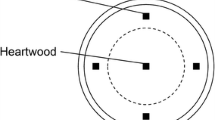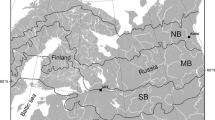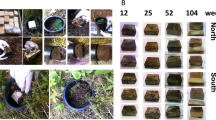Abstract
Wood decay activity of Omphalotus guepiniformis, one of the most frequently occurring fruiting bodies on beech coarse woody debris in cool temperate forests in Japan, was estimated in situ by chronosequence with a five decay class system. The decay columns of O. guepiniformis increased from decay class 1 to decay class 2, where they occupied 20.2% of the total area of cross sections, and was estimated to be a dominant basidiomycete. The decay columns of O. guepiniformis decreased after decay class 2 and were not detected in decay class 5. The relative density of the decay columns of O. guepiniformis decreased to 0.33 g cm−3 in decay class 2 (58.9% of fresh beech wood) but did not decrease thereafter. The lignocellulose index (LCI) of the decay columns of O. guepiniformis slightly decreased during the decay process while remaining in the range of white-rot. In contrast, the decay columns of microfungi increased in the later stages of decomposition and LCI of these decay columns decreased significantly alongside the decay process. These results suggest that O. guepiniformis has an important role in simultaneous decomposition of acid-unhydrolyzable residue (AUR, Klason lignin) and holocellulose in the early stages of beech log decomposition, while holocellulose selective decomposition by microfungi may occur in the late stages of decomposition.



Similar content being viewed by others
References
Barker JS (2008) Decomposition of Douglas-fir coarse woody debris in response to differing moisture content and initial heterotrophic colonization. For Ecol Manage 255:598–604
Berg B, McClaugherty C (2003) Plant litter. Decomposition, humus formation, carbon sequestration. Springer, Berlin
Boddy L (1991) Importance of wood decay fungi in forest ecosystems. In: Arora DK, Rai B, Mukerji KG, Knudsen GR (eds) Handbook of applied mycology, vol. 1: soil and plants. Marcel Dekker, New York, pp 507–539
Boddy L, Owens EM, Chapela IH (1989) Small scale variation in decay rate within logs one year after felling: effect of fungal community structure and moisture content. FEMS Microbiol Ecol 62:173–184
Bütler R, Patty L, Bayon R-CL, Guenat C, Schlaepfer R (2007) Log decay of Picea abies in the Swiss Jura Mountains of central Europe. For Ecol Manage 242:791–799
Christensen O (1984) The states of decay of woody litter determined by relative density. OIKOS 42:211–219
Coates D, Rayner ADM (1985a) Fungal population and community development in cut beech logs. I. Establishment via the aerial cut surface. New Phytol 101:153–171
Coates D, Rayner ADM (1985b) Fungal population and community development in cut beech logs. II. Establishment via the buried cut surface. New Phytol 101:173–181
Coates D, Rayner ADM (1985c) Fungal population and community development in cut beech logs. III. Spatial dynamics, interactions and strategies. New Phytol 101:183–198
Dubois M, Gilles KA, Hamilton JK, Rebers PA, Smith F (1956) Colorimetric method for determination of sugars and related substances. Anal Chem 28:350–356
Environment Agency of Japan (2000) Threatened wildlife of Japan—Red data book 2nd ed.—vol. 9: bryophytes, algae, lichens, fungi (in Japanese with English abstract). Japan Wildlife Research Center, Tokyo
Eriksson K-EL, Blanchette RA, Ander P (1990) Microbial and enzymatic degradation of wood and wood components. Springer, Berlin
Fukasawa Y (2003) Heterogeneity of wood chemical property within decomposing beech logs reflecting fungal community structure and fungal decay ability. Master Thesis, Kyoto University, Kyoto
Fukasawa Y, Osono T, Takeda H (2002) Fungal community structure and physical and chemical properties of decaying beech logs in a cool temperate natural forest (in Japanese with English abstract). Appl For Sci 11:7–14
Fukasawa Y, Osono T, Takeda H (2005a) Decomposition of Japanese beech wood by diverse fungi isolated from a cool temperate deciduous forest. Mycoscience 46:97–101
Fukasawa Y, Osono T, Takeda H (2005b) Small-scale variation in chemical property within logs of Japanese beech in relation to community structure and functional diversity of fungi. Mycoscience 46:209–214
Fukasawa Y, Osono T, Takeda H (2009a) Dynamics of physicochemical properties and occurrence of fungal fruit bodies during decomposition of coarse woody debris of Fagus crenata. J For Res 14:20–29
Fukasawa Y, Osono T, Takeda H (2009b) Microfungus communities of Japanese beech logs at different stages of decay in a cool temperate deciduous forest. Can J For Res 39:1606–1614
Harmon ME, Franklin JF, Swanson FJ, Sollins P, Gregory SV, Lattin JD, Anderson NH, Cline SP, Aumen NG, Sedell JR, Lienkaemper GW, Cromack K, Cummins KW (1986) Ecology of coarse woody debris in temperate ecosystems. Adv Ecol Res 15:133–302
Hillis WE (1987) Heartwood and tree exudates. Springer, Berlin
Kawase K (1962) Chemical components of wood decayed under natural condition and their properties. J Fac Agric Hokkaido Univ 52:186–345
King HGC, Heath GW (1967) The chemical analysis of small samples of leaf material and the relationship between the disappearance and composition of leaves. Pedobiologia 7:192–197
Lambert RL, Lang GE, Reiners WA (1980) Loss of mass and chemical change in decaying boles of a subalpine balsam fir forest. Ecology 61:1460–1473
Lopez-Real JM, Swift MJ (1975) The formation of pseudosclerotia (‘zone lines’) in wood decayed by Armillaria mellea and Stereum hirsutum. II. Formation in relation to the moisture content of the wood. Trans Br Mycol Soc 64:473–481
Means JE, MacMillan PC, Cromack K (1992) Biomass and nutrient content of Douglas-fir logs and other detrital pools in an old-growth forest, Oregon, U.S.A. Can J For Res 22:1536–1546
National Institute of Health (2008) ImageJ: image processing and analysis in Java. Version 1.41 [online]. http://rsb.info.nih.gov/ij/. Accessed 24 May 2009
Neda H (2004) Type studies of Pleurotus reported from Japan. Mycoscience 45:181–187
Osono T, Takeda H (2001) Organic chemical and nutrient dynamics in decomposing beech leaf litter in relation to fungal ingrowth and succession during 3-year decomposition processes in a cool temperate deciduous forest in Japan. Ecol Res 16:649–670
Preston CM, Trofymow JA, Sayer BG, Niu J (1997) 13CPMAS NMR investigation of the proximate analysis of fractions used to assess litter quality in decomposition studies. Can J Bot 75:1601–1613
Progar RA, Schowalter TD, Freitag CM, Morrell JJ (2000) Respiration from coarse woody debris as affected by moisture and saprotroph functional diversity in Western Oregon. Oecologia 124:426–431
Rayner ADM, Boddy L (1988) Fungal decomposition of wood: its biology and ecology. Wiley, Chichester
SAS Institute (2004) JMP statistical discovery software (ver. 5.1.1). SAS Institute Inc., Cary
Schmidt O (2006) Wood and tree fungi: biology, damage, protection, and use. Springer, Berlin
Shimaji K, Sudou S, Harada H (1980) Mokuzai no soshiki (in Japanese). Morikita Publishing, Tokyo
Tanaka H, Enoki A, Fuse G, Nishimoto K (1988) Interactions in successive exposure of wood to varying wood-inhabiting fungi. Holzforschung 42:29–35
Temnuhin VB (1996) Preliminary quantitative estimation of wood decomposition by fungi in a Russian temperate pine forest. For Ecol Manage 81:249–257
Vainio EJ, Hantula J (2000) Direct analysis of wood-inhabiting fungi using denaturing gradient gel electrophoresis of amplified ribosomal DNA. Mycol Res 104:927–936
Vasiliauskas R, Lygis V, Larsson K-H, Stenlid J (2005) Airborne fungal colonisation of coarse woody debris in North Temperate Picea abies forest: impacts of season and local spatial scale. Mycol Res 109:487–496
Worrall JJ, Wang CJK (1991) Importance and mobilization of nutrients in soft rot of wood. Can J Microbiol 37:864–868
Yang D-Q (2005) Isolation of wood-inhabiting fungi from Canadian hardwood logs. Can J Microbiol 51:1–6
Yoneda T (1975) Studies on the rate of decay of wood litter on the forest floor. I. Some physical properties of decaying wood. Jpn J Ecol 25:40–46
Acknowledgments
We thank Nobu Endo, Osamu Tateno, Hitomi Mizuta, Akihiro Shimizu, Yusuke Hagiwara, and members of Laboratory of Forest Ecology, Kyoto University, for their help in field and laboratory works. Thanks are extended to the staff of Kamigamo Experimental Forest of Kyoto University for technical support. Financial support for this study was provided by the Research Fellowship Division, Japan Society for the Promotion of Science.
Author information
Authors and Affiliations
Corresponding author
About this article
Cite this article
Fukasawa, Y., Osono, T. & Takeda, H. Beech log decomposition by wood-inhabiting fungi in a cool temperate forest floor: a quantitative analysis focused on the decay activity of a dominant basidiomycete Omphalotus guepiniformis . Ecol Res 25, 959–966 (2010). https://doi.org/10.1007/s11284-010-0720-4
Received:
Accepted:
Published:
Issue Date:
DOI: https://doi.org/10.1007/s11284-010-0720-4




